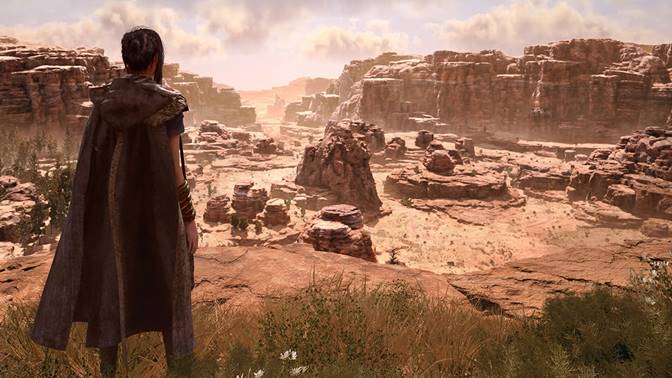Are you struggling with performance in Forspoken?
Well, this guide will help you get the correct Graphics Settings for Forspoken that would help you with performance and also retain the game’s excellent visual quality.
I know Graphics are Performance do not complement each other. However, you just need to know how to adjust your visual settings to get the best out of it and not lose out on performance at the same time.

Forspoken- Best Graphics Settings to Fix Stuttering, Lag, and Drops
Forspoken is a PlayStation exclusive, but hard luck for the old-gen users as the game is only released for PS5 and PC. This is one of the games that would definitely put any hardware to test.
Talk about breathtaking graphics combined with smooth-flowing combat, a decent story, special effects, and never-ending exploration. This game has it all.
You play as Frey, a young New Yorker transported to the beautiful and cruel land of Athia. In search of a way home, Frey must use her newfound magical abilities to traverse sprawling landscapes and battle monstrous creatures.
This game is no joke when it comes to requirements. Users are already complaining about optimization. We are here to understand that not every PC will be able to handle the game. So before we jump into the Graphics Settings let us talk about the System Requirements for this Game.
MINIMUM:
-
- Requires a 64-bit processor and operating system
- OS: Windows® 10 64-bit (After November 2019 Update) or Windows® 11 64-bit
- Processor: AMD Ryzen™ 5 1600 (3.7GHz or better) / Intel® Core™ i7-3770 (3.7GHz or better)
- Memory: 16 GB RAM
- Graphics: AMD Radeon™ RX 5500 XT 8GB / NVIDIA® GeForce® GTX 1060 6 GB VRAM
- DirectX: Version 12
- Storage: 150 GB available space
- Additional Notes: 720p 30fps
RECOMMENDED:
-
- Requires a 64-bit processor and operating system
- OS: Windows® 10 64-bit (After November 2019 Update) or Windows® 11 64-bit
- Processor: AMD Ryzen™5 3600 (3.7 GHz or better) / Intel® Core™ i7-8700K (3.7GHz or better)
- Memory: 24 GB RAM
- Graphics: AMD Radeon™ RX 6700 XT 12GB / NVIDIA® GeForce® RTX 3070 8 GB VRAM
- DirectX: Version 12
- Storage: 150 GB available space
- Additional Notes: 1440p 30fps, SSD 150GB
These are the system requirements for Forspoken according to Steam. You can understand how demanding the game is. So let me make one thing clear. Quite often users tend to force-run a game on systems that are not capable of handling the game.
If you do not have a config equivalent to or better than the minimum requirements, then there is no point trying to expect better performance from the game because you would not be able to run it smoothly. In some cases, the game might not launch at all.
Best Graphics Settings for Forspoken:
I am not talking about the beast PCs here. They would obviously run the game maxed out. No point trying to do settings guide for them. It is the average PCs and in this case the ones that come between the recommended and the minimum requirements.
Honestly, the best performance settings will always be with everything on Low. But then what fun is there in playing on the lowest settings? Forspoken is one of those games that could boast of its visual quality and we need to experience at least some of it.
To get the best of both worlds, try out these settings:
Settings> Display Settings:
- Resolution: Native ( This is what gives you the best experience. If you have a 1080p monitor, play on 1920×1080. Use whatever is your monitor resolution.)
- Brightness: Depends on the User
- Gamma Settings: Depends on the User
- Maximum Frame Rate: 120 FPS (Capping FPS could make your game more stable, but to get the maximum FPS you need to set it to the real maximum value. Here it is 120 FPS)
- Vsync: Off
- Screen Mode: Fullscreen (Borderless and Windowed give you less performance. Always use fullscreen.)
- Select Main Display: Depends on the number of monitors you have.
- Color Filter Option: Depends on the User
- Filter Strength: Depends on the User
Settings>Graphics:
- Variable Rate Shading: On (this increases performance but turn it off for better visuals)
- Dynamic Resolution: Off (We do not want the game to keep changing the resolution every time. So we set this to off and to the native resolution of our monitor.)
- Model Memory: Standard (More memory allocation for 3D models. If you have less VRAM then go for Low or Standard. Anything above this would significantly affect performance.)
- Texture Memory: Low or Standard (Higher than this you would need a lot of VRAM and this could result in stutters and bad performance.)
- AMD FidelityFX Super Resolution 2: Off
- Nvidia DLSS: Quality/Balanced. (You can use either of the two. This basically upscales a resolution lower to your currently selected resolution and gives you a sharp crisp image so that you can enjoy more performance. Quality is the best for me, however, if you are too obsessed with performance then go ahead and use Balanced or even Performance and the new Ultra Performance Mode as well. But the game would not look good at all, that is the downside of this. Quality is still good though)
- Sharpness: 0.80
- Render Resolution: 100%
- Model Detail Level: Standard
- Texture Filtering: Low or Standard
- Reflections: Standard
- Motion Blurr: Off
- Depth of Feild: On
- Fog Quality: Low (Affects performance by a lot it seems. Better we keep it on low. The game looks pretty clean at low.)
- Cloud Quality: Low (If you love staring at the sky then why not crank this up? But for me, it does not really make any difference.)
- Shadow Quality: Low (Affect performance by a lot. Hence keep it on Low)
- Ray Traced Shadows: Off (Brings down Performance by a lot)
- Ambient Occlusion: Standard or High (Lighting is really good in this game so I would rather use the Standard or High setting instead of Low)
- Ray Traced Ambient Occlusion: Off (Brings down Performance by a lot)
- Anti-Aliasing: Temporal AA
There you go, these are the best graphics settings for Forspoken. However, different configs would react differently to these settings, the best way to find out is to experiment with what I have shown here. Play around with these settings and see what works best for you.
You can try to set it up as I have shown and then tweak these settings one by one to see how well each setting works with your PC. It also depends on how much FPS you are willing to sacrifice for visuals or vice versa.
I hope the guide was helpful. Please let us know in the comments section down below.

Arya is an avid gamer and a full-time content writer. His love for games is so unconditional that despite having a degree in Mass Communication he chose to have a career in the blogging world. He is a FIFA lover and has played every single FIFA game released since 2005. His knowledge of Sports Games is impeccable and every single article he writes is backed by years of experience.
